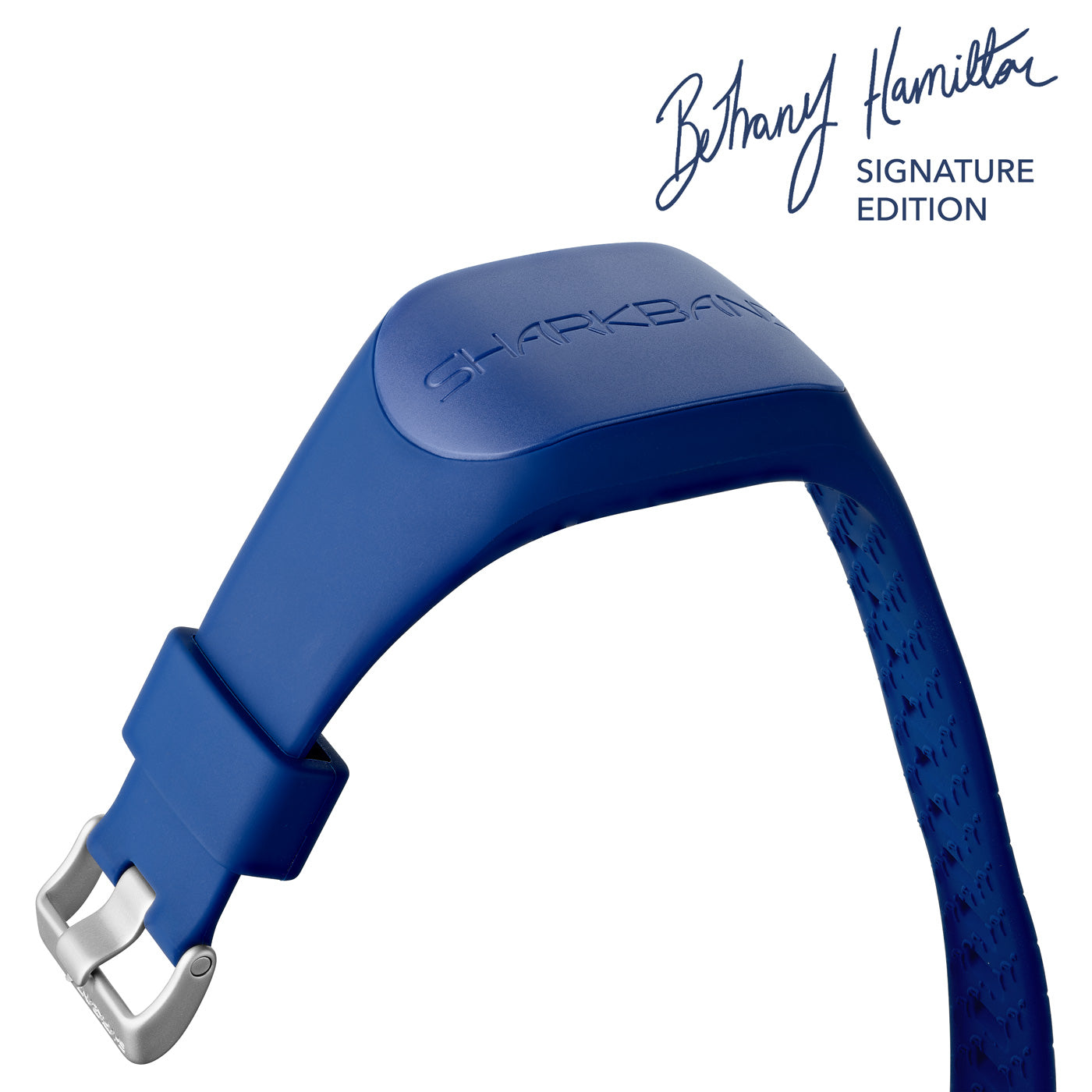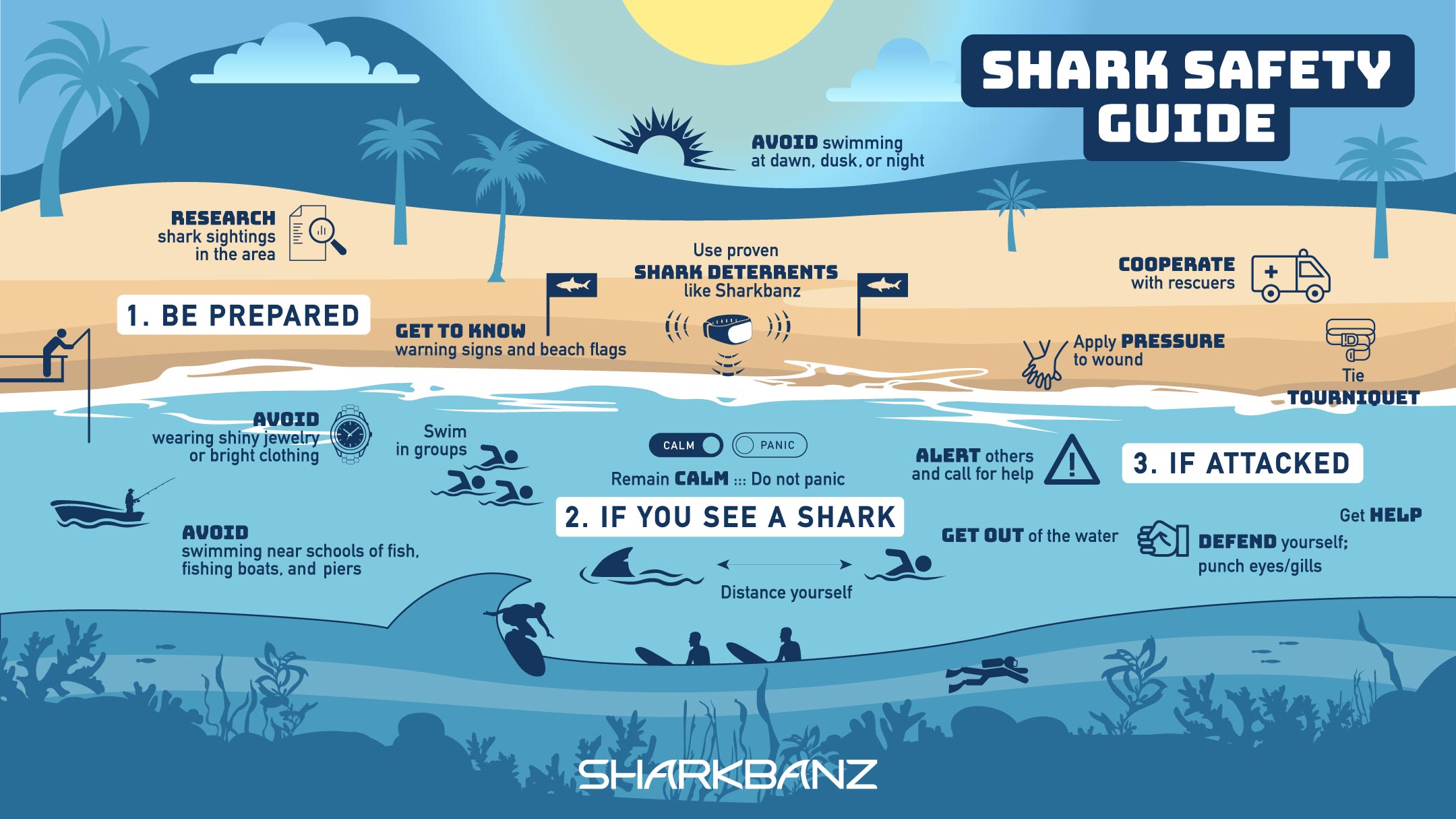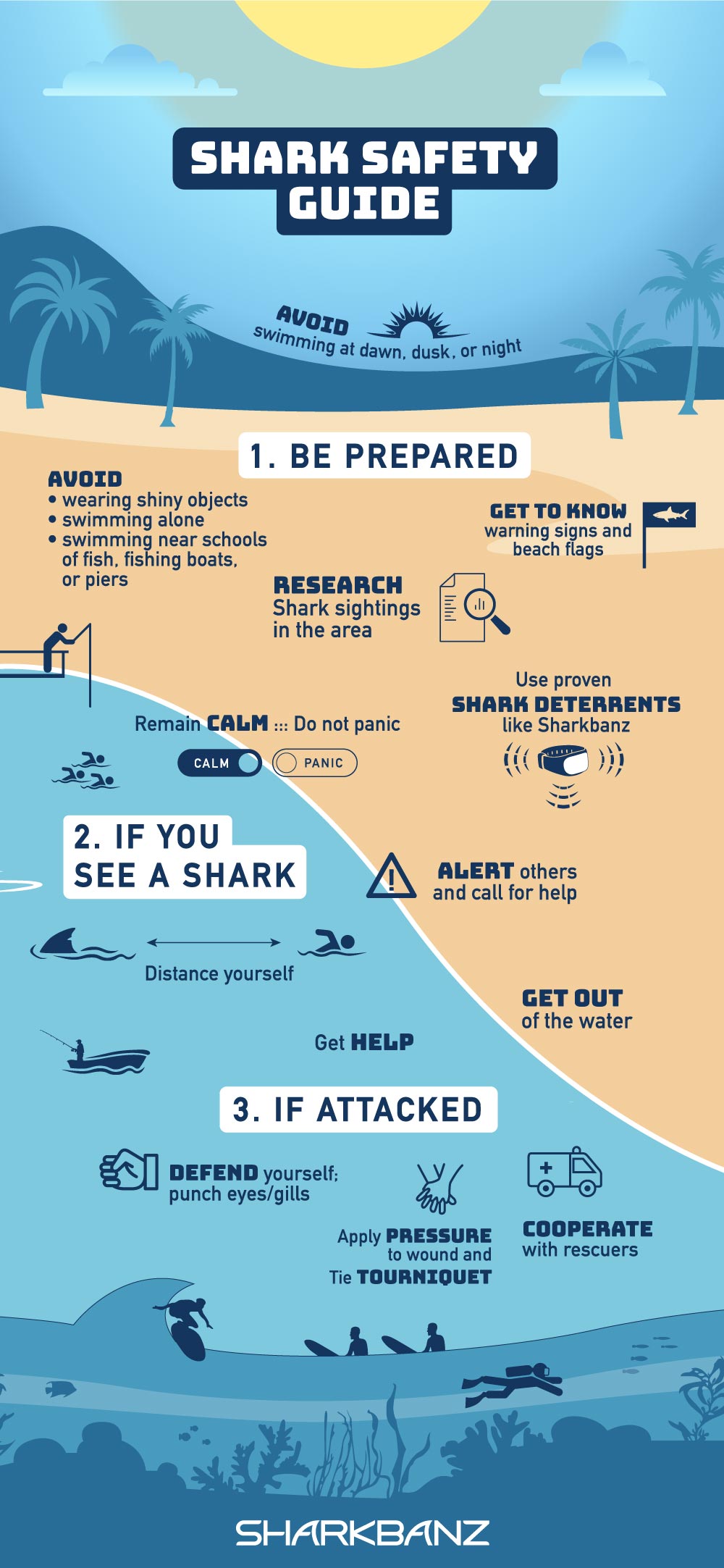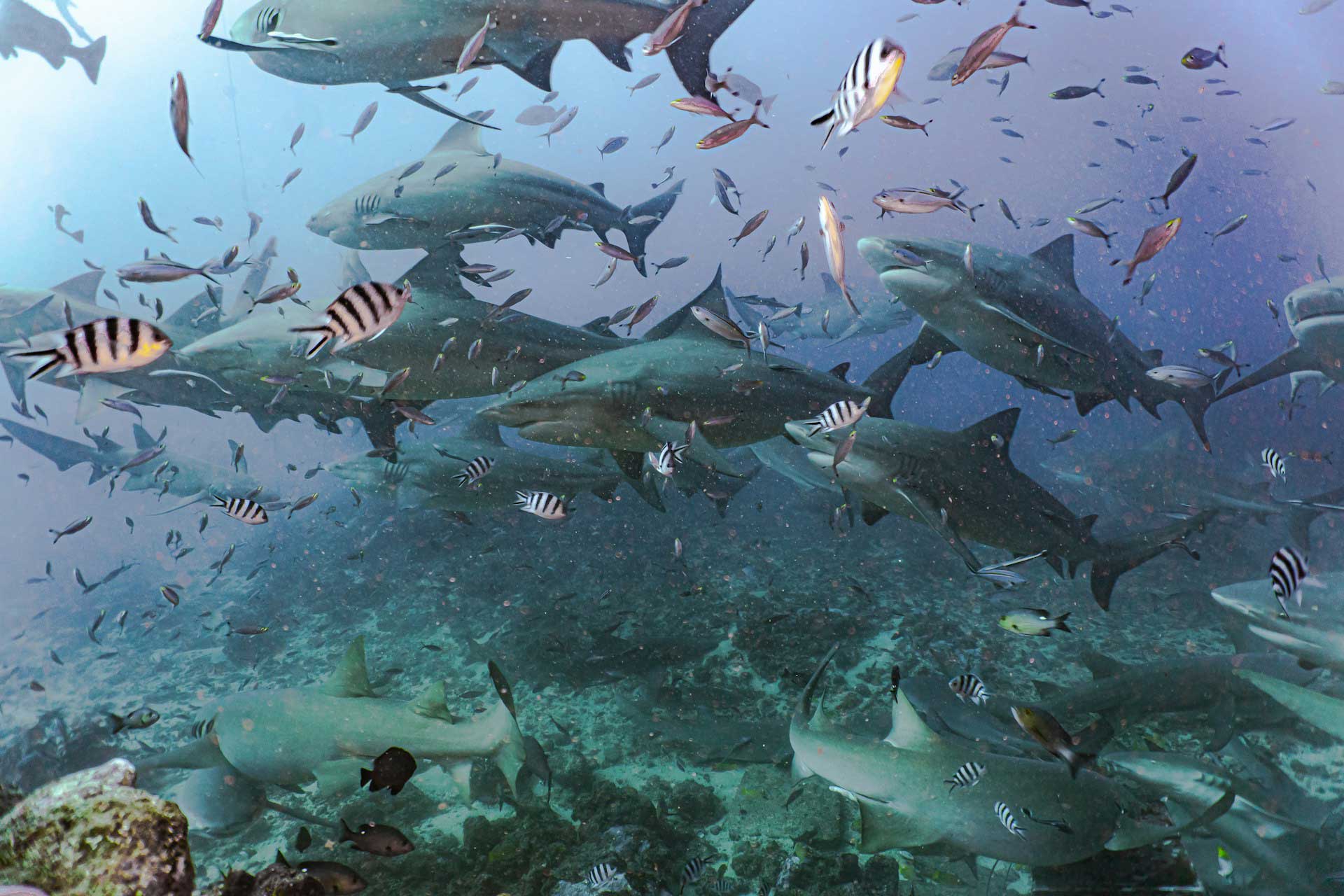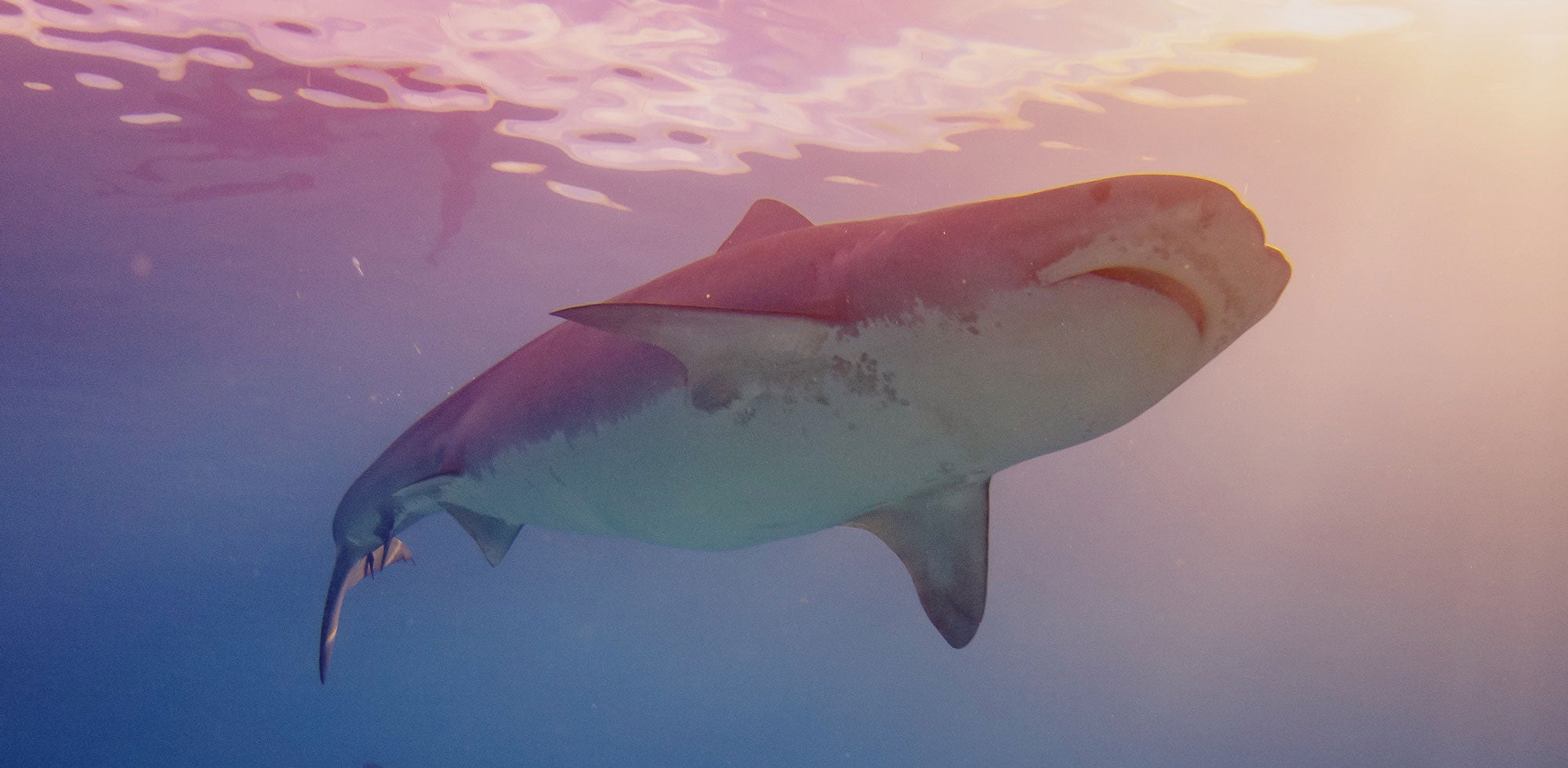How to Avoid and Survive a Shark Attack
Shark Smart Safety Guide
At Sharkbanz, our mission is to provide solutions to reduce conflict between humans and sharks. Technology together with education are critical in order to reduce the risk and to maximize your ocean experiences. Use our infographic, articles, and checklists to learn practical safety strategies and important background information on shark behavior.
By understanding shark behavior and why sharks attack (bite), people can modify their behavior in the water to minimize the chances of a shark bite. Explore each section for crucial tips and insights to help keep you safe.
Understanding Shark Behavior:
- Which sharks attack people?
- What do sharks eat?
- When do sharks feed?
- Why do sharks attack people?
How To Avoid Shark Attacks (and How to Survive a Shark Attack, Too):
- What to do before you get in the water
- What to do if you see a shark or a shark is circling you
- What to do if you are attacked by a shark
Shark Safety Checklist:
- Safety Checklist for Swimming and Surfing in shark populated areas
- Safety Checklist for Spearfishers, Divers, and Snorkelers
References:
Click here to view our reference information sources.
Sharing the Same Space
Sharks naturally hunt and travel in nearshore habitats
Watch examples of how predatory shark species share our most common ocean setting.
If you plan to enter the water in an area where dangerous sharks are known to be present, there are several things you can do to minimize the risk of an attack:
- Research: One of the best ways to avoid a shark attack is by understanding the geographic location where you will be swimming. Before entering the water, research the area and find out if there have been any recent shark sightings or attacks. Local and regional governments will often provide information on their websites explaining warning signs and flags posted on the beach, as well as the dangers of sharks in the area. In Western Australia, for example, the government launched an app specifically designed to keep beachgoers informed about recent shark sightings.
- Avoid wearing shiny jewelry or bright clothing: Sharks are attracted to shiny objects, so avoid wearing jewelry or clothing that reflects light. Particularly in murky water, a shark may confuse shiny jewelry or high-contrast clothing with the reflection of fish scales and mistake it for prey.
- Swim / Surf / Play in Groups: You are more likely to be attacked by a shark if you are alone than when you are with a group of people, so bring a friend if you can or swim close to other groups of people.
- Avoid ocean activities at dawn, dusk, or night: Depending on the species, sharks can be more active during these times. In addition, the lack of visibility diminishes your ability to detect the presence of sharks and the ability of sharks to properly identify their prey. As a result, sharks may mistakenly target you as prey and be able to approach you undetected.
- Do not swim near schools of fish, fishing boats, or piers: If you see schools of fish jumping out of the water or birds diving into the sea in certain areas, you should consider exiting the water, as large groups of fish can draw sharks. Both recreational and commercial fishermen often discard unwanted fish and fish parts, which can also attract sharks. Avoid these areas and rely on your research to find beaches monitored by a lifeguard and/or beach patrol. Lifeguards and beach patrol are excellent resources, so if you have any questions, you should feel free to approach them and always heed their advice.
- Plan for what to do if you see a shark and how to survive a shark attack: In the rare event that you do encounter a shark, there are some key behaviors that you can exhibit to communicate to the shark or sharks that you are a predator like them, and not preay, while calmly and vigilantly distancing yourself from the threat. We cover these tips in more detail below.
- Wear Sharkbanz shark deterrents: Sharkbanz shark deterrent devices use patented magnetic technology to deter sharks from approaching. The devices, which can be purchased as sleek and non-intrusive wearables, use powerful permanent magnets to generate an electromagnetic field that overwhelms a shark’s electrical sensory organ, which can create avoidance behavior from the animals. Marine biologists and shark experts endorse Sharkbanz as an effective device for reducing the risk of shark attacks.
Encountering a shark can be a terrifying experience, but how you react can spell the difference between a shark sighting and a shark attack. Most importantly, you want to communicate to the shark that you are aware of its presence and that you are a predator, but you are not a threat to it unless it attacks you. Here are some guidelines to follow if you see a shark or think a shark is circling you:
- Do Not Splash and Remain Calm: Sharks are typically not interested in humans as a food source, and attacks are usually a result of mistaken identity or defensive behavior. Staying calm can help you think clearly and make rational decisions. A calm demeanor can also communicate to the shark that you are not prey. There are several breathing techniques that can aid in keeping calm. One effective technique is to focus on taking a deep inhale through the nose while counting “one,” exhaling slowly through the mouth while counting “two,” and then repeating the exercise. Deep breaths should help slow your heart rate and provide you with sufficient oxygen to make intelligent decisions, like wading gently away from the shark rather than thrashing around or otherwise attracting a shark’s attention.
- Make Eye Contact: If you can, maintain eye contact with the shark as it approaches to help signal strength. Sharks often attack from behind, so keeping the shark in your line of sight can help deter it from attacking. Remember that several sharks may be present, so once you make firm eye contact with the shark, be sure to check your surroundings for other threats.
- Slowly Distance Yourself: If the shark is swimming towards you, slowly and calmly move away from it without turning your back. Try to keep a distance of at least 6 feet (about 1.8 meters) between you and the shark. If you have fins, face the shark and put your fins between you and the shark as protection as you calmly swim away. Do not flail your arms and legs, and do not create surface splashes.
- Get Out of the Water: If possible, leave the water as soon as you see a shark. Remember that some sharks can attack in surprisingly shallow waters, so as soon as you are alerted to the threat of a shark, seek dry land immediately. Be purposeful and act with intent.
- Alert Others: Alert others about the presence of the shark and call for help. Remember that sharks are less likely to attack you if you are in a group than if you are alone.
If you are attacked by a shark, it is important to know that by defending yourself and quickly getting to safety, you have a high likelihood of surviving. Of the 57 unprovoked shark attacks in 2022, only five of them were fatal. Here are some guidelines to follow if you are attacked by a shark:
- Defend Yourself: You remained calm when you initially spotted the shark, but now that the shark has made a move to bite, take action. Sharks can often be deterred before biting by firmly pushing the snout of the animal up and away. This is much easier when diving, and may not be possible when surfing or swimming. If you do not have the proper angle to push the snout, use your fists and any available objects to defend yourself. Aim for the shark's eyes, nose, or gills, as these are their most sensitive areas. When striking the nose, be wary of missing too low and exposing your hand to the mouth of the shark.
- Get Help: If possible, signal for help or call for assistance as soon as you can. Try to stay afloat and keep your head above water. Remember to keep an eye on the shark to defend against repeated aggression.
- Apply Pressure to Wounds: If you are bleeding, apply pressure to the wound as soon as possible. This can help slow down the bleeding and reduce the risk of shock. If blood continues to pulsate from the wound, be prepared to use items at your disposal, such as a surfboard leash or the contents of a first aid kit, to apply a tourniquet.
- Seek Medical Attention: Once you are safely out of the water, seek medical attention immediately. Shark bites can cause serious injuries, including deep wounds, broken bones, infection, and internal injuries.
- Cooperate with Rescuers: When rescue personnel arrives, you should fully cooperate with them and follow their instructions. They will have the training and equipment necessary to best care for the injured person.
Sharkbanz co-founder Nathan Garrison recalls an encounter while surfing in South Africa a couple of years ago.
As an experienced surfer with knowledge of shark safety, Nathan took the necessary precautions before paddling out. He knew Great White sharks frequented the spot where he would be surfing and therefore equipped himself with a Sharkbanz x Modom shark deterrent leash and wrist wearable.
Not long into his session, he was in between waves when two fins emerged from the water about 70 meters away. With a clear mind, he noticed both a dorsal fin and caudal (tail) fin when the figure re-emerged, a tell-tale sign that he was dealing with a shark and not a dolphin or whale. Sharks have vertical caudal fins, whereas the tail fins of dolphins and whales are horizontal. The fact that he could see the shark’s tail fin also indicated that it was large, as smaller species’ tail fins are less prominent.
His training immediately kicked in — he remained calm and paddled efficiently toward shore, catching a small wave to the beach.
Depending on what you will be doing in the water, there are different methods to avoid shark attacks. That is why we tailored a shark safety checklist for surfers and swimmers, and another shark safety checklist for spearfishers, divers, and snorkelers.
Safety Checklist for Swimming and Surfing:
- Research shark sightings in the area and gain a deeper understanding of the types of sharks you may encounter in the water, their feeding habits, and their motivations for attacking you. ☐
- Research local government websites where you will be swimming and find out if there have been any recent shark sightings or attacks. ☐
- Avoid wearing shiny jewelry or brightly colored clothing. ☐
- Stay with a buddy or group of people. ☐
- Do not venture too far from the shoreline. ☐
- Although studies have shown that sharks are not particularly drawn to human blood, they can sense it, so just to be safe, stay out of the water with bleeding cuts or wounds. ☐
- Avoid swimming and surfing at dawn, dusk, and night, which are times when visibility is low, increasing the chances of a shark mistaking you for their prey. ☐
- Keep away from murky, dirty water and water near sewage drains. ☐
- Do not swim near fishing boats, piers, or other areas used by recreational or commercial fishermen. ☐
- Avoid areas with signs of bait fish or fish-feeding activity; jumping fish and diving seabirds are good indicators of schools of fish. ☐
- If you see dolphins, keep in mind that sharks may still be present, as they often feed on the same food. Some species of sharks, such as Great White sharks, have even been known to feed on dolphins. ☐
- Be aware that sharks may be present between sandbars or near steep drop-offs in water depth. ☐
- Avoid swimming and surfing in canals, river mouths, and estuaries. ☐
- Do not take your pets in sharky water with you, as their splashing could attract sharks. ☐
- If there are shark nets or other shark mitigation measures, stay far away from them. ☐
- If you see a shark, remain calm and do not splash around. Slowly retreat from the shark and get out of the water, then alert other people in the water and inform lifeguards (if present). ☐
- Use Sharkbanz shark deterrent wearables to reduce the risk and provide extra peace of mind. ☐
- If a shark attacks you, defend yourself by targeting the gills, eyes, and nose; get help immediately; apply pressure to the wounds; and cooperate with the rescuers while seeking medical attention. ☐
Safety Checklist for Spearfishers, Divers, and Snorkelers:
- Research shark sightings in the area and gain a deeper understanding of the types of sharks you may encounter in the water, their feeding habits, and their motivations for attacking you. ☐
- Research local government websites where you will be swimming and find out if there have been any recent shark sightings or attacks. ☐
- Plan for how to respond to a shark encounter. ☐
- Avoid wearing shiny jewelry or brightly colored clothing. ☐
- Remember that the less visibility you have, the more vulnerable you are, so pay attention to factors that affect the clarity of the water and your ability to see. ☐
- Always work with a buddy or team and discuss a plan ahead of time that includes dive logistics and contingency plans. The team should also be clear about hand signals, entry and exit strategies, and what to do if someone gets separated. ☐
- Be aware that using bait to lure fish may attract sharks. ☐
- If you see a shark, do not provoke it in any way. Try to make eye contact with the shark, while remaining aware of your surroundings for other sharks that may be in the area. ☐
- Use your speargun to push away aggressive sharks. Avoid shooting the shark, as this can create an even more dangerous situation by provoking it. Plus, you may lose the gun. Shooting a shark should be the last resort. ☐
- Slowly and calmly distance yourself from the shark. If you have fins, stay facing the shark and put your fins between you and the shark as you swim away. ☐
- Do not attempt to feed a shark while underwater. ☐
- Pay close attention to the shark’s behavior. If you see any signs of aggression or agitation, then exit the water immediately without drawing attention to yourself. ☐
- Pay attention to the behavior of other fish. If they suddenly jump out of the water and/or flee the area, it could be an indication that a shark is nearby. ☐
- If you catch or otherwise have fish, do not attach the fish to your body or keep them close to you; instead, use a float and line to keep a safe distance between you and the fish. ☐
- Use Sharkbanz wearable deterrent and fishing tackle to reduce the risk and provide extra peace of mind. ☐
- If a shark attacks you, defend yourself by targeting the gills, eyes, and nose; get help immediately; apply pressure to the wounds; and cooperate with the rescuers while seeking medical attention. ☐
While the risk of a shark attack is low, it is important to take precautions when entering waters where particular sharks have been known to roam. By understanding shark behavior and why sharks attack humans, and applying some simple safety tips, you can reduce the risk of a shark attack. For extra peace of mind, we highly recommend Sharkbanz patented shark repellent wearable and fishing products as reliable and effective tools for deterring sharks.
Sharks are wild, but with preparation and the help of shark repellent technology, people can enter the water with the confidence that they can reduce the risk of shark attacks.
Reduce the Risk
Shop Sharkbanz
